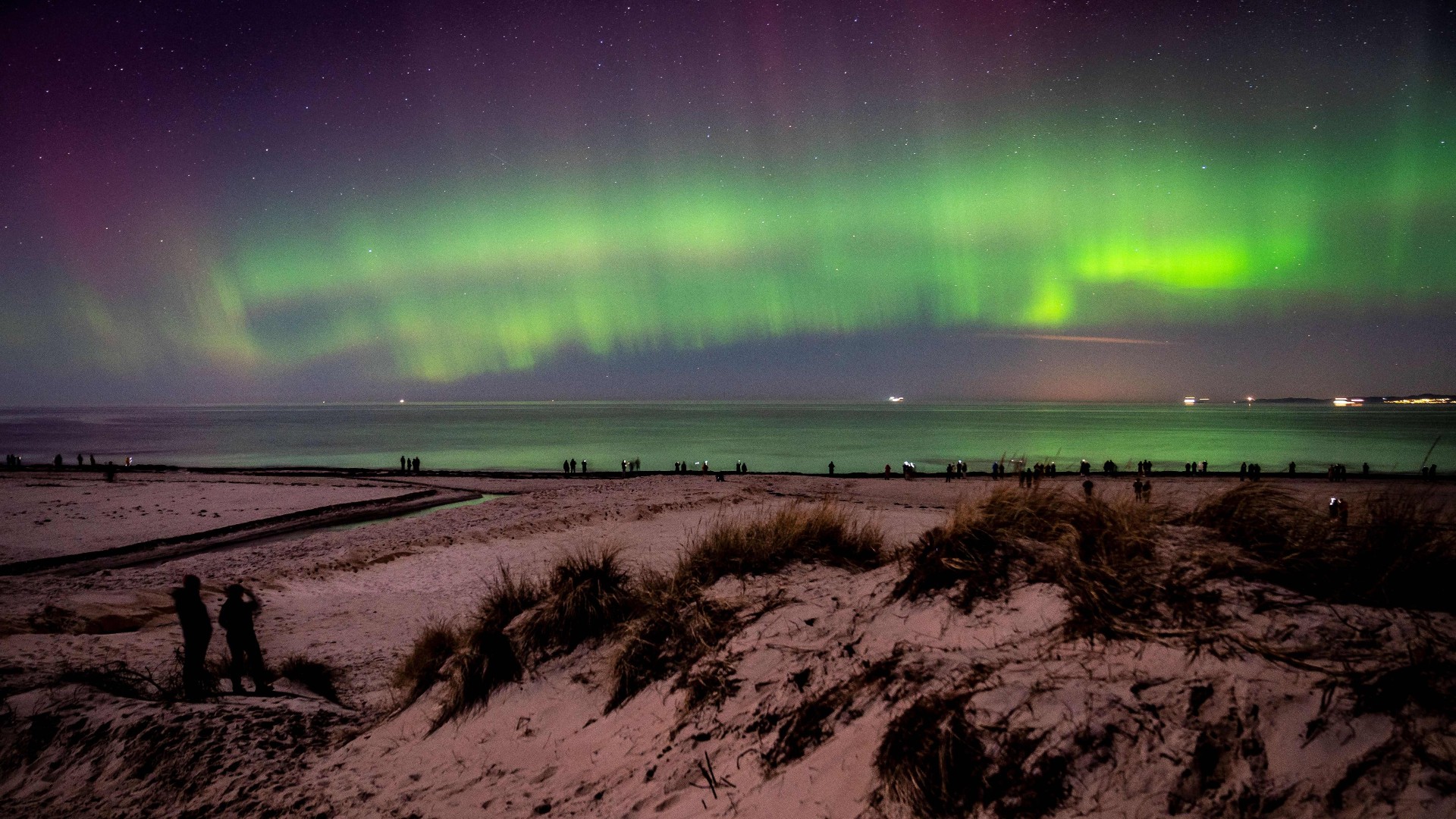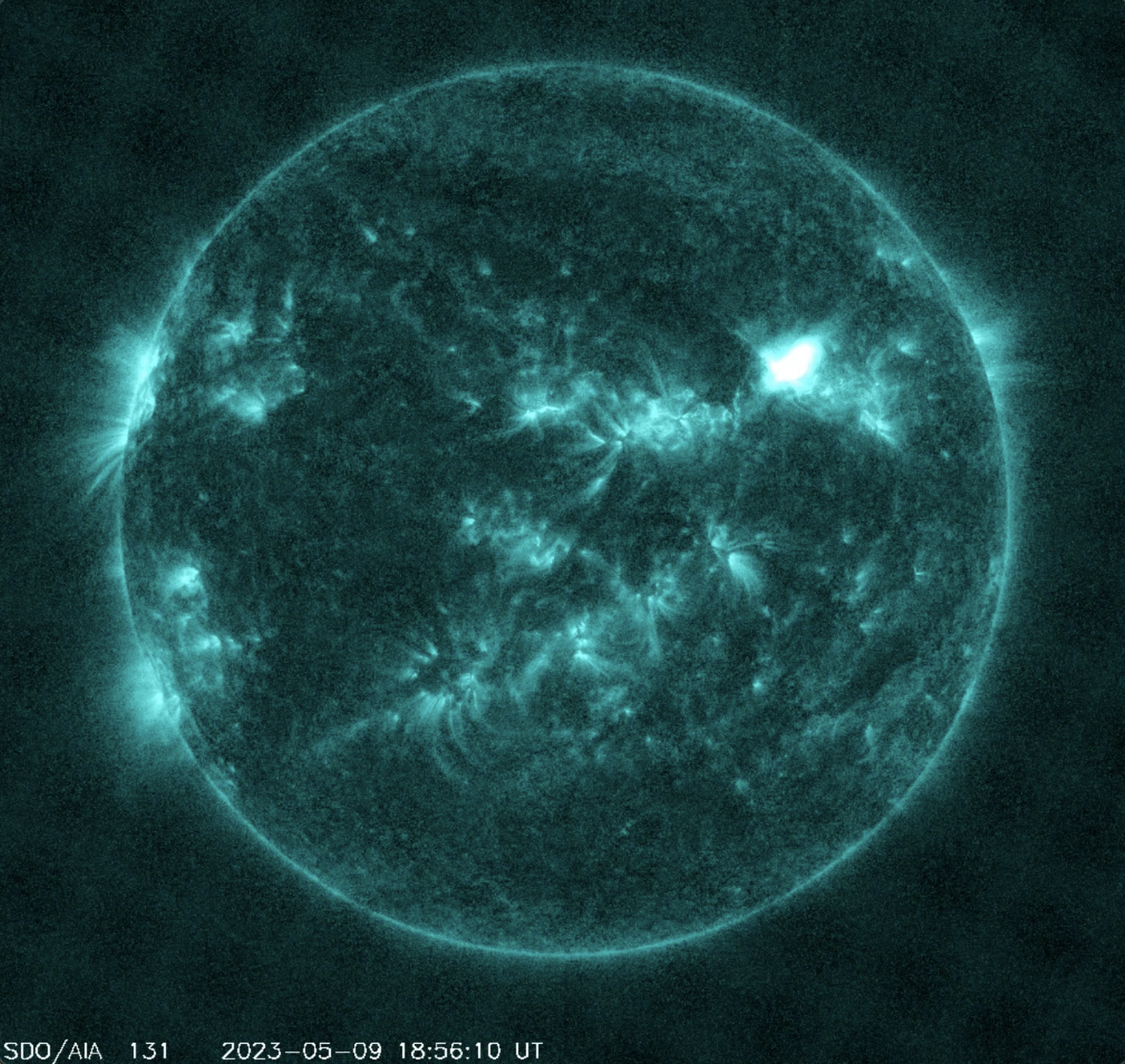A powerful eruption on the sun could create widespread auroras tonight
A pair of eruptions seen on the sun on Tuesday (May 9) might lead to a display of the northern lights for parts of the northern and central United States tonight.
Late Tuesday, the satellite known as the Solar and Heliospheric Observatory, or SOHO, detected a significant coronal mass ejection (CME) which likely was spawned by the double flare outburst that afternoon. The associated subatomic material appears to be headed directly toward Earth and, as a result, the Space Weather Prediction Center at the National Oceanographic and Atmospheric Administration (NOAA) has issued a geomagnetic storm watch for a possible G3 event today (May 11).
Such a geomagnetic storm might allow auroras to be visible as far south as the border of Oregon and northern California, Denver, Colorado and the Outer Banks of North Carolina.
Related: Northern lights (aurora borealis): What they are & how to see them
For much of this past week, the sun has been behaving in a highly disturbing manner. Since May 5, a sunspot cataloged as AR3296 has been slowly working its way across the disk of the sun and in the process has hurled no fewer than nine magnetically charged "M" class solar flares toward Earth. These flares have caused frequent disruptions or even blackouts in shortwave radio communications throughout the world. Compass needles have danced back and forth, while utility companies have braced for stray surges of current that could even knock out their power lines.
But on Tuesday (May 9), within a time span of less than two hours, two significant solar flares erupted from sunspot AR3296. Great streams of subatomic particles shot out from these solar disturbances at terrific speeds of 2.2 million mph (1.3 million km/h). When these particles encounter Earth's magnetic field, some of them may be accelerated and channeled down to areas around the North and South Poles.
Magnetic storm watch now in effect
Predicting space weather events, like Earth-based weather, has its uncertainties. The expected magnetic storm could be stronger or weaker than forecast. And its arrival time is also highly uncertain; some computer models suggested that it would happen earlier this morning, but as of this writing, we are still waiting for the subatomic material spewed from Tuesday's double flare event to reach Earth.
Breaking space news, the latest updates on rocket launches, skywatching events and more!
Expectations are that this electrified material will reach Earth sometime Thursday afternoon (May 11), ultimately colliding with molecules of oxygen and nitrogen, as well as atoms of the rarefied gases of the upper atmosphere. These atoms are temporarily stripped of some of their electrons by the collision or near collision. The atoms absorb energy in the process. Within a millionth of a second the atoms regain their lost electrons and re-emit this energy in the form of light of various colors in much the same physical process that light is emitted from a neon sign.
We call such a display in the night sky the aurora borealis, more popularly known as the northern lights.
When and where to look
Typically, visibility of the aurora is usually confined to Alaska, northern Canada and Iceland, where displays are visible in various forms as many as 200 or more nights per year. But sometimes when a particularly potent disturbance erupts on the sun, the visibility zone for seeing the lights can be pushed much farther south.
Skywatchers who hope to catch a glimpse of the northern lights should make a concerted effort to go to a location well away from bright city lights and check the northern skies as soon as it gets sufficiently dark and then make periodic checks of the sky at regular intervals. Auroral activity can be dormant, then suddenly flare up at moment's notice. The most common form appears low to the northern horizon and is called a homogeneous arc. If activity is increasing, the arc may appear to pulsate with rays of light emerging and ascending into the sky. Other forms take the appearance of spots or patches of light or flames.
As for colors, green and white are the most commonly seen, though blue and red auroras have also been noticed as well.
Smoke could hinder viewing
One handicap which could seriously hinder viewers over the northern tier and northeast U.S. is the presence of airborne smoke emanating from wildfire activity over western Canada. Upper-level winds have been blowing this smoke in an east-southeast direction, creating a distinct haziness to the sky. This haze has been producing deep red-colored sunrises and sunsets, but has also been dimming or even squelching completely, views of faint stars at night.
For best views of a potential auroral display, clear, transparent skies are desired. But the smoky skies currently affecting much of southern Canada and the northern U.S. could serve to either mute or completely obscure tonight's possible display of polar lights.
Joe Rao serves as an instructor and guest lecturer at New York's Hayden Planetarium. He writes about astronomy for Natural History magazine, the Farmers' Almanac and other publications. Follow us on Twitter @Spacedotcom and on Facebook.

Joe Rao is Space.com's skywatching columnist, as well as a veteran meteorologist and eclipse chaser who also serves as an instructor and guest lecturer at New York's Hayden Planetarium. He writes about astronomy for Natural History magazine, Sky & Telescope and other publications. Joe is an 8-time Emmy-nominated meteorologist who served the Putnam Valley region of New York for over 21 years. You can find him on Twitter and YouTube tracking lunar and solar eclipses, meteor showers and more. To find out Joe's latest project, visit him on Twitter.


